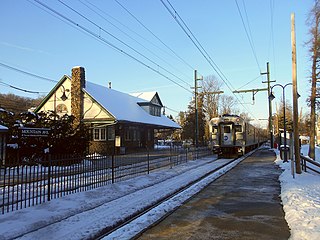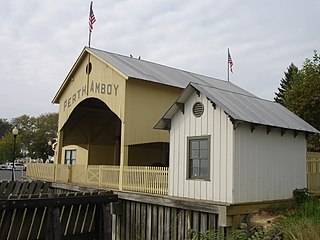The following ferries once crossed the North River (Hudson River) between New York City and New Jersey. There was no ferry service between 1967 [1] [2] and 1989, when it was restarted by New York Waterway. [3]
Contents



The following ferries once crossed the North River (Hudson River) between New York City and New Jersey. There was no ferry service between 1967 [1] [2] and 1989, when it was restarted by New York Waterway. [3]



| Name | Manhattan end | New Jersey end | Operated | Notes |
|---|---|---|---|---|
| Bulls Ferry | Bulls Ferry | 18th century | Bergen Township | |
| Communipaw | Fort Amsterdam | Communipaw ferry | 1661- [4] [3] | charter granted by Peter Stuyvesant, Director-General of New Netherland |
| Budd's Ferry [5] | Cortlandt Street | Harsimus | 1808–1818 | |
| Weehawken Ferry [6] | Weehawken Street? | Weehawken Cove? | 1700- | royal patent from Richard Coote, 1st Earl of Bellomont [7] |
| Burdett's Landing | Bloomingdale | Edgewater Fort Lee | 1758- | Hackensack Township |
| Tubby Hook Ferry [8] | Dyckman Street | Closter Dock? [9] | ||
Team boats served New York City for "about ten years, from 1814-1824. They were of eight horse-power and crossed the rivers in from twelve to twenty minutes." [10]
In 1812, two steam boats designed by Robert Fulton were placed in use in New York, for the Paulus Hook Ferry from the foot of Cortlandt Street, and on the Hoboken Ferry from the foot of Barclay Street. The Juliana, running from Barclay Street, was withdrawn from service, as announced, in favor of the "more convenient" horse boat. It is almost certain, however, that this retrograde step was taken because of the monopoly enjoyed by Mssrs. Fulton and Livingston for the navigation of the waters of New York State by steam. [11]





North River is an alternative name for the southernmost portion of the Hudson River in the vicinity of New York City and northeastern New Jersey in the United States. The entire watercourse was known as the North River by the Dutch in the early seventeenth century; the term fell out of general use for most of the river's 300+ mile course during the early 1900s. The name remains in limited use among local mariners and others and on some nautical charts and maps. The term is also used for infrastructure on and under the river, such as the North River piers, North River Tunnels, and the North River Wastewater Treatment Plant.

The Kearny Connection is a railroad junction in Kearny, New Jersey that allows passenger trains from New Jersey Transit's Morris and Essex Lines to enter/leave Amtrak's Northeast Corridor (NEC) and travel to and from New York Penn Station. The junction, which opened in 1996 and utilizes Swift Interlocking, is nearby the Sawtooth Bridges.

The Morris and Essex Railroad was a railroad across northern New Jersey, later part of the main line of the Delaware, Lackawanna and Western Railroad.

The Pennsylvania Railroad Station was the intermodal passenger terminal for the Pennsylvania Railroad's (PRR) vast holdings on the Hudson River and Upper New York Bay in Jersey City, New Jersey. By the 1920s the station was called Exchange Place. The rail terminal and its ferry slips were the main New York City station for the railroad until the opening in 1910 of New York Pennsylvania Station, made possible by the construction of the North River Tunnels. It was one of the busiest stations in the world for much of the 19th century.

The Central Railroad of New Jersey Terminal, also known as Communipaw Terminal and Jersey City Terminal, was the Central Railroad of New Jersey's waterfront passenger terminal in Jersey City, New Jersey. The terminal was built in 1889, replacing an earlier one that had been in use since 1864. It operated until April 30, 1967.

Walnut Street is a New Jersey Transit station on Walnut Street at Depot Square in Montclair, New Jersey along the Montclair-Boonton Line. It is the most used station on the Montclair–Boonton Line. Walnut Street is the second or fifth of six stops that are in Montclair along the Montclair-Boonton line. It gets its name from the street that crosses the railroad tracks next to the station. It has a farmers' market in its parking lot from the summer to the early fall.

Watchung Avenue is a New Jersey Transit station at the intersection of Watchung Avenue, Watchung Plaza, and Park Street in Montclair, New Jersey along the Montclair-Boonton Line. The Watchung Avenue station is on an elevated embankment between Watchung Plaza and Park Street. The outbound platform faces the plaza, while the inbound platform and the station house are on the Park Street side. The station house has a waiting room with a bathroom and a former post office and ticket booth. Service to and from this station is weekdays only, with all service stopping at intermediate points.

Mountain Avenue is a New Jersey Transit station in Montclair in Essex County, New Jersey, United States, along the Montclair-Boonton Line. The station is located on Upper Mountain Avenue, which gives the station its name.

The Pavonia Ferry was a ferry service on the Hudson River which conveyed passengers between New York City and Jersey City. It was launched in 1854. It was sold to the Pavonia Ferry Company of Jersey City for what was considered a low price of $9,050, at New York City Hall, in February 1854.

The Binghamton was a ferryboat that transported passengers across the Hudson River between Manhattan and Hoboken from 1905 to 1967. Moored in 1971 at Edgewater, Bergen County, New Jersey, United States, the ship was operated as a floating restaurant from 1975 to 2007. In 2017, following ten years of damage that effectively rendered the boat unrestorable, the ferry was dismantled. No structural components were salvaged.

Benson Street is a former train station in a residential section of the town of Glen Ridge, New Jersey.

Pompton Plains is a former railroad station in Pequannock Township, Morris County, New Jersey. United States. Located at 33 Evans Place in the Pompton Plains section of Pequannock, the station is a former stop on the Erie Railroad's Greenwood Lake Division. The station was a single side-platform station with service from Wanaque–Midvale station in Wanaque to Pavonia Terminal in Jersey City, where connections were made to ferries to New York City. The next station north was Pompton–Riverdale after 1951. The next station south was Pequannock station.

The Perth Amboy Ferry Slip, located on the Arthur Kill in Perth Amboy, Middlesex County, New Jersey, United States, was once a vital ferry slip for boats in New York Harbor. It was added to the New Jersey Register of Historic Places and National Register of Historic Places in 1978. The ferry slip was restored in 1998 to its 1904 appearance. A replica of the ticket office has been constructed and is used as a small museum.

The Chambers Street Ferry Terminal was the Erie Railroad's main ferry slip on Manhattan and the point of departure and embarkation for passengers in New York City. The terminal was one of several operated by ferry companies and railroads that lined the western shore of Manhattan during the 19th and 20th centuries. The Pavonia Ferry operated for over 100 years from the terminal, which was demolished about three years after the Erie Railroad stopped its ferry service to Chambers Street in December, 1958.

Liberty Street Ferry Terminal or Liberty Street Terminal was the Central Railroad of New Jersey's passenger ferry slip in lower Manhattan, New York City and the point of departure and embarkation for passengers travelling on the Central Railroad of New Jersey, Baltimore and Ohio Railroad, Reading Railroad and the Lehigh Valley Railroad from the Communipaw Terminal across the Hudson River in Jersey City.

Cortlandt Street Ferry Depot was the main ferry terminal of the Pennsylvania Railroad and the West Shore Railroad on the North River in lower Manhattan. The railroads operated ferries to their terminal stations on the Hudson River waterfront in New Jersey at Exchange Place and Weehawken, respectively.

The Desbrosses Street Ferry was a ferry route across the Hudson River in the 19th and 20th centuries. It provided passengers with ferry service between the Pennsylvania Railroad's Exchange Place station at Jersey City and Desbrosses Street in lower Manhattan where an elevated railway station at Ninth Avenue was located and where the Metropolitan Crosstown Line provided a connection to the Grand Street Ferry.

The Jersey City Ferry was a major ferry service that operated between Jersey City in New Jersey and Cortlandt Street in lower Manhattan for almost 200 years (1764-1949). The ferry was notable for being the first to use steam power which began in 1812. The ferry's history was closely tied to the Pennsylvania Railroad's station in Jersey City at Exchange Place, which gradually fell into disuse after the railroad opened the North River Tunnels and Penn Station in 1910. Ferry service from lower Manhattan to Jersey City continued via the even older Communipaw ferry which operated from the adjacent Liberty Street Ferry Terminal until this service was also discontinued in 1967. In 1986 ferry service was revived and today it is operated by New York Waterway.
The Communipaw Ferry was a major ferry service that operated between the village of Communipaw and Lower Manhattan, New York. The ferry began operations in 1661 after the Colonial Dutch administrators of New Amsterdam granted a charter to operate the ferry. soon after the establishment of Bergen atop Bergen Hill. It was the first reported ferry service established across the Hudson River and it remained active up until 1783 when New York City was captured by the British.